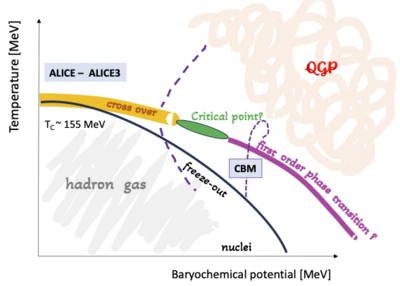Our research interests
Quarks and gluons are the fundamental building blocks of matter, yet under normal conditions, they are confined within hadrons such as protons and neutrons due to the strong nuclear force. The phase diagram of nuclear matter, illustrated here on the side, depicts how nuclear matter behaves at high temperatures and/or densities.
Consider water: when heated to a critical temperature, it transitions from liquid to vapor. Similarly, fossils of dinosaurs or plants, when heated to around 1,800 K and subjected to pressures of approximately 50,000 kg/cm², transform into diamonds. Both these transitions exemplify how substances change their state under extreme temperature and pressure.
This prompts the question: what happens when we heat or compress protons and neutrons? Lattice QCD calculations predict that at temperatures above approximately 160 MeV (around 2×10¹² K, which is 100,000 times hotter than the Sun’s core), quarks and gluons are no longer confined within hadrons. Instead, they form a new phase called the quark-gluon plasma (QGP). At the Large Hadron Collider (LHC), experiments aim to produce and study this state to deepen our understanding of the strong force.
To explore high-density regimes, astronomers turn their gaze skyward. Neutron stars are the universe’s most compact objects, with masses up to twice that of the Sun compressed into a radius of just 5–15 km. The densities within their cores can surpass four or five times that of normal nuclear matter, though what exactly constitutes their internal composition remains uncertain. The equation of state (EoS) -the relationship between internal pressure and density- serves as a key link between the star’s internal properties and its observable characteristics, such as mass and radius, especially when analyzed through general relativity.
Recent observations of neutron star mergers via gravitational wave signals provide additional means to test hypotheses about their internal makeup. The simplest assumption is that neutron stars are composed mainly of neutrons, some protons, electrons, and neutrinos. However, at densities exceeding twice nuclear density, it becomes energetically favorable for neutrons to be replaced by hyperons—hadrons containing at least one strange quark, such as the Λ hyperon (uds). The equation of state involving nucleons and hyperons depends on hyperon-nucleon and hyperon-nucleon-nucleon interactions, which change as density increases. Neutron stars could also include other hadrons like kaons (K⁺ = u-anti-s) or antikaons (K⁻ = s-anti-d). Their production is favored because, as bosons, they can occupy the same energy ground state, affecting the star’s internal dynamics.
Our research group at TUM actively investigates these phenomena through several experimental collaborations:
- In ALICE:
- We seek to understand hyperon-nucleon and hyperon-nucleon-nucleon interactions in a vacuum via femtoscopy. Since scattering data and hypernuclei measurements are limited, femtoscopy—techniques that probe the size and evolution of the particle-emission region on femtometer scales—can reveal details about strong final-state interactions. We focus on proton-proton and proton-nucleus collisions at various energies (GeV to TeV) to study these interactions, which are vital for modeling the equation of state of neutron stars.
- We study the properties of the quark-gluon plasma (QGP) and the conditions—such as temperature and baryon chemical potential—under which it forms in heavy-ion collisions. Surprisingly, the QGP behaves more like a nearly perfect liquid with strong interactions and our goal is to distinguish initial geometric effects from hydrodynamic phenomena using advanced correlation techniques and to accurately measure the QGP’s initial temperature through thermal radiation emissions.
- in R3B
- We want to investigate nuclear structure via precise spectroscopy measurements of neutron-rich and rare nuclei. This allows us not only to test the boundaries of the nuclear landscape, but also to learn more details about the many body strong interactions that occur in nuclei and also in neutron stars.
- with HYPER
- We want to build the first hypernuclei (nuclei where an hyperon replaces one nucleon) factory at CERN where neutron-rich hypernuclei can be examined and we can learn about the strong interaction that binds hyperons inside nuclei. This also has consequences for the physics of neutron stars.
- with CBM
- We want to measure the properties of nuclear matter at its highest densities to look for a phase transition and possibly a critical point. This offers us the opportunity to cover the full nuclear matter diagram.
Through these efforts, we aim to deepen our understanding of matter under extreme conditions, from the microcosm of quark interactions to the macrocosm of neutron stars.
